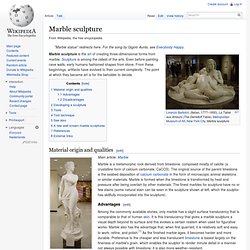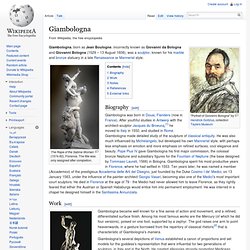

The Best Artists. THE WORLD'S LARGEST RODIN WEBSITE - COMPLETE OVERVIEW ... Canova. Marble sculpture. Marble sculpture is the art of creating three-dimensional forms from marble.

Sculpture is among the oldest of the arts. Even before painting cave walls, early humans fashioned shapes from stone. From these beginnings, artifacts have evolved to their current complexity. The point at which they became art is for the beholder to decide. Ancient Sculpture Gallery Reproductions World Best Museum Masterpieces. Giambologna. Giambologna, born as Jean Boulogne, incorrectly known as Giovanni da Bologna and Giovanni Bologna (1529 – 13 August 1608), was a sculptor, known for his marble and bronze statuary in a late Renaissance or Mannerist style.

The Rape of the Sabine Women (1574-82), Florence. The title was only assigned after completion. Anthony Gormley. Early life[edit] The youngest of seven children born to a German mother and an Irish father,[1] Gormley grew up in a wealthy Roman Catholic[2] family living in Dewsbury Moor, West Yorkshire.[1] He attended Ampleforth College, a Benedictine boarding school in Yorkshire,[1] before reading archaeology, anthropology and the history of art at Trinity College, Cambridge, from 1968 to 1971.[1] He travelled to India and Sri Lanka to learn more about Buddhism between 1971 and 1974.[1] After attending Saint Martin's School of Art and Goldsmiths in London from 1974, he completed his studies with a postgraduate course in sculpture at the Slade School of Fine Art, University College, London, between 1977 and 1979.

Sladmore Gallery London based specialists in fine art bronze sculptures. Auguste Rodin. François-Auguste-René Rodin (12 November 1840 – 17 November 1917), known as Auguste Rodin (/oʊˈɡuːst roʊˈdæn/ oh-GOOST roh-DAN; French: [oɡyst ʁɔdɛ̃]), was a French sculptor.

Although Rodin is generally considered the progenitor of modern sculpture,[1] he did not set out to rebel against the past. He was schooled traditionally, took a craftsman-like approach to his work, and desired academic recognition,[2] although he was never accepted into Paris's foremost school of art. Sculpturally, Rodin possessed a unique ability to model a complex, turbulent, deeply pocketed surface in clay. Many of his most notable sculptures were roundly criticized during his lifetime.
They clashed with the predominant figure sculpture tradition, in which works were decorative, formulaic, or highly thematic.
Figure. Painting. An Artist's Journey. Some of you may have noticed that my posting has been sporadic as of late. One of the big reasons for that is I have been working hard on getting everything ready to launch my business in a few months time. I know that I have mentioned little pieces about it, but I now have my confirmed logo designed by Karen Rubado (see above - isn't it beautiful) and feel like I am close to being ready so I now feel good about talking about it to you all. The name of my business is (as you can probably guess) Possibility Ltd. Art Essays into Art. S C R I B B L E R. Donelli DiMaria - Fine Art. Donelli (Dan) J.

DiMaria and Diane M. DiMaria are an artist couple who live and work in Santa Fe, New Mexico. Dan is primarily an oil painter and Diane is a fiber artist. Audrey Hepburn Complex. History-of-art: Balthus -Therese on a Bench-seat (1939) i-donline:Open the door to Elliot Erwitt’s world of Kolor.

LOOK. Cjgittings's favorite websites (StumbleUpon) Maria Cristina BARACCHI Online Gallery. Look-E-Here. Linda Horvitz Post. Andrews gibson. Posted by Andrew S Gibson on April 15th 2014 The Visual Imagination In Slow I wrote about, amongst other techniques utilising slow shutter speeds, using intentional camera movement to create expressive photos that capture atmosphere and emotion.

David duChemin takes that idea further in his new ebook The Visual Imagination, released this week at Craft & Vision. Read the rest of this entry » Posted by Andrew S Gibson on April 08th 2014 How to Prepare Photos for the Web in Lightroom Lightroom isn’t just a tool for processing Raw files. Design boom.
Davidson galleries. Miriam Schulman Watercolor Portraits and Fine Art Commissions. Julia Davey Home. Arts. Figure Drawing - How To Information. Art Drawing - How To Information. Immaterials: Light painting WiFi. The city is filled with an invisible landscape of networks that is becoming an interwoven part of daily life.

WiFi networks and increasingly sophisticated mobile phones are starting to influence how urban environments are experienced and understood. We want to explore and reveal what the immaterial terrain of WiFi looks like and how it relates to the city. Immaterials: light painting WiFi film by Timo Arnall, Jørn Knutsen and Einar Sneve Martinussen. This film is about investigating and contextualising WiFi networks through visualisation. Édouard Manet. Biography[edit] Born into an upper class household with strong political connections, Manet rejected the future originally envisioned for him, and became engrossed in the world of painting.

He married Suzanne Leenhoff in 1863. The last 20 years of Manet's life saw him form bonds with other great artists of the time, and develop his own style that would be heralded as innovative and serve as a major influence for future painters. Tizian. During the course of his long life, Titian's artistic manner changed drastically[4] but he retained a lifelong interest in color.

Although his mature works may not contain the vivid, luminous tints of his early pieces, their loose brushwork and subtlety of tone are without precedent in the history of Western art. Biography[edit] Early years[edit] The exact date of Titian's birth is uncertain. When he was an old man he claimed in a letter to Philip II, King of Spain, to have been born in 1474, but this seems most unlikely.[6] Other writers contemporary to his old age give figures which would equate to birthdates between 1473 to after 1482.[7] Most modern scholars believe a date nearer 1490 is more likely; the Metropolitan Museum of Art's timeline supports c.1488, as does the Getty Research Institute.[8]
William Adolphe Bouguereau. William-Adolphe Bouguereau (French: [buɡ(ə)ʁo]; November 30, 1825 – August 19, 1905) was a French academic painter and traditionalist. In his realistic genre paintings he used mythological themes, making modern interpretations of classical subjects, with an emphasis on the female human body.[1] During his life he enjoyed significant popularity in France and the United States, was given numerous official honors, and received top prices for his work.[2] As the quintessential salon painter of his generation, he was reviled by the Impressionist avant-garde.[2] By the early twentieth century, Bouguereau and his art fell out of favor with the public, due in part to changing tastes.[2] In the 1980s, a revival of interest in figure painting led to a rediscovery of Bouguereau and his work.[2] Throughout the course of his life, Bouguereau executed 822 known finished paintings, although the whereabouts of many are still unknown.[3] Life and career[edit] The Wave (1896) Fame, fall, and rise[edit]
Artists blog. Tesia Blackburn, author of Acrylic Painting With Passion, speaks to the difficulty of portraying reality, and the idea of playing with abstraction to convey your message. "There is always something just under the surface of things," says artist John Jude Palencar. Celebrate National Craft Month by participating in the Art Abandonment movement, where artists leave random works of art in public spaces to inspire and delight others. “In many of my water paintings," says Charlene Gerrish, “I focus almost solely on the reflections, because that’s where the strongest graphic possibilities lie. I love when a painting looks like an abstract design up close, but reveals its true subject at a distance. " Read more here! It stands to reason that the more you do something, the better you’ll get.
“The subject of Ray is my brother,” says Debra Carr. Rex and Susan Beanland are retired teachers whose paths of sharing knowledge didn’t end, but rather began anew once they left the classrooms. William Fox Talbot. William Henry Fox Talbot (11 February 1800 – 17 September 1877) was a British inventor and photography pioneer who invented the calotype process, a precursor to photographic processes of the 19th and 20th centuries.
Talbot was also a noted photographer who made major contributions to the development of photography as an artistic medium. His work in the 1840s on photo-mechanical reproduction led to the creation of the photoglyphic engraving process, the precursor to photogravure. Talbot is also remembered as the holder of a patent which, some say, affected the early development of commercial photography in Britain. Additionally, he made some important early photographs of Oxford, Paris, Reading, and York.[1] Libby Jones. Art Tutorial. The second bit of advice a beginning artist usually gets is “draw from life”. A u d r e y * k a w a s a k i.
Art News. Early Christian art and architecture. Early Christian art and architecture (or Paleochristian art) is the art produced by Christians or under Christian patronage from the earliest period of Christianity to, depending on the definition used, some time between about 350 and 525. Art Attack. AR-Gallery: Dealers of Artwork. Francois Boucher. Craig Pitman's Portfolio. Curated Online Exhibitions. Be As You Are - Fun & Funky Stuff. E M I L Y * A L L C H U R C H.
Exploring the Culture of Technology. Art Moderne & Contemporain [en cours...] Cambridge Art Gallery Contemporary Canvas Art and Watercolors. Jeanne Ivy's artist Self-Portrait Page. Architect's Blog - The Resident Architect. Neo Gothic. Gothic Revival (also referred to as Victorian Gothic, Neo-Gothic or Jigsaw Gothic, and when used for school, college, and university buildings as Collegiate Gothic) is an architectural movement that began in the late 1740s in England. Its popularity grew rapidly in the early 19th century, when increasingly serious and learned admirers of neo-Gothic styles sought to revive medieval Gothic architecture, in contrast to the neoclassical styles prevalent at the time. Gothic Revival architecture often has certain features,derived from the original Gothic architecture style, including decorative patterns, finals, scalloping, lancet windows, hood moldings and label stops.
Dream Anatomy: A National Library of Medicine Exhibit. Sweet Station. Zemer Peled. Scott hovind. Robert Hemphill. Alex Mathers Illustration.